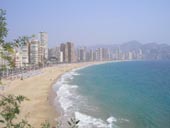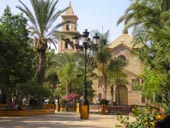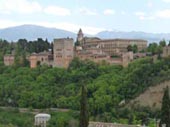Spain
Brief history and guide to Spain, the second largest Western European country.



Countries of Europe - Spain
Spain - Occupying about 85% of the Iberian Peninsular in south-western Europe, Spain has borders with France, Portugal, Gibraltar and Andorra and has a coastline on the Mediterranean Sea, the Atlantic Ocean, the Bay of Biscay and the Cantabric Sea. Spain has a total area of 504,000 km2 and a population of over 45 million, the country comprises mainland Spain, the Canary Islands (off the coast of West Africa) and the Balearic Islands in the Mediterranean Sea, it is the second largest Western European country (after France).
A member of the European Community since 1986 its government is organised as a Parliamentary Democracy and the country is a Constitutional Monarchy with its current King Juan Carlos I.
Spain has a long and complex history going back some 35,000 years, its earliest inhabitants were thought to be Cro- Mangons. Later came the Celts and the Iberians and during the Roman occupation Hispania (as the region was the called) became one of the most significant regions in the Roman Empire. After the Romans came the Visigoths a strange race of germanic peoples and these were replaced by the Moors during what was the most influential period in Spanish history. During the 8th to 13th Centuries almost the entire Iberian Peninsular came under Muslim rule and both the architecture and the culture of Spain have been influenced by this period right up to the present day.
In the years following the discovery of the Americas by Christopher Columbus (1492), Spain became the strongest and wealthiest nation in Europe and also became an important sea-power., however much of Spain's wealth was squandered in constant wars and much of its influence was reduced by the middle of the 17th Century.
After the War of Spanish Succession (1701-1714) Spain was ruled by the French Bourbons and by the end of the 18th Century was enjoying some renewed wealth and stabilty. However further wars with Napoleonic France and America plunged the country once again into political turmoil.
The situation remained unstable throughout the 19th Century and early 20th Century leading eventually to the bitter and damaging Spanish Civil War (1936-1939), when Nationalist forces led by General Franco took control of the country. Spain remained neutral throughout World War Two and sunk further into political and economic isolation during the 1940's and 1950's.
In what later became known as 'The Spanish Miracle', Spain enjoyed a huge economic revival during the 1960's no doubt fuelled by the huge rise in tourism during this period.
With the death of Franco in 1975, Prince Juan Carlos was installed as King of Spain and democracy arrived once again in the form of the new Spanish Constitution of 1978.
Spain now has a modern industrial economy and a thriving tourist industry, particularly along the Mediterranean coastline, it has the 9th largest economy in the world and the 5th largest in Europe.
Spain joined the rest of Western Europe in 2002 and adopted the euro as its currency, the euro replaced the peseta.
Spanish Food: Spanish Omelette - Spanish Omelette Recipe - Tortilla - Tortilla Recipe
Articles: Pyrenees - Banos de Tus
Regions: Extremadura - Galicia - Aragon - Castilla La-Mancha - Andalucia
Related: Andalucia - Catalonia - Galicia - Valencia - Madrid - Barcelona - Builders
HOME
